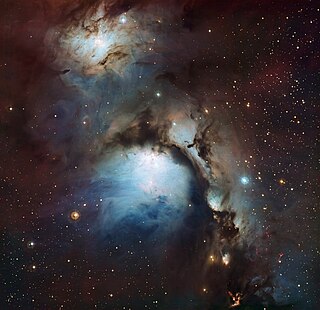
Messier 78 or M78, also known as NGC 2068, is a reflection nebula in the constellation Orion. It was discovered by Pierre Méchain in 1780 and included by Charles Messier in his catalog of comet-like objects that same year.

NGC 4319 is a face-on barred spiral galaxy located about 77 million light years away in the constellation Draco. The morphological classification is SB(r)ab, which indicates it is a barred spiral with an inner ring structure and moderate to tightly wound arms. It is situated in physical proximity to the galaxies NGC 4291 and NGC 4386, with X-ray emissions from the intervening gap indicating NGC 4319 and NGC 4291 may be interacting. NGC 4319 has a much higher proportion of ionized hydrogen compared to the Milky Way galaxy.

NGC 4639 is a barred spiral galaxy located in the equatorial constellation of Virgo. It was discovered by German-born astronomer William Herschel on April 12, 1784. John L. E. Dreyer described it as "pretty bright, small, extended, mottled but not resolved, 12th magnitude star 1 arcmin to southeast". This is a relatively nearby galaxy, lying approximately 72 million light-years away from the Milky Way. It is a companion to NGC 4654, and the two appear to have interacted roughly 500 million years ago. NGC 4639 is a member of the Virgo Cluster.
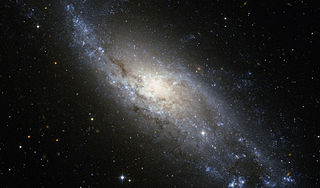
NGC 406 is a spiral galaxy quite similar to the well known Whirlpool Galaxy, located some 65 million light-years away, in the southern constellation of Tucana and discovered in 1834 by John Herschel. It is described in the New General Catalogue as "faint, very large, round, very gradually a little brighter middle". NGC 406 is about 60000 light-years across, roughly half the diameter of the Milky Way.

NGC 4654 is an intermediate spiral galaxy in the constellation of Virgo at a distance of 55 million light years from the Milky Way that can be spotted with amateur telescopes.

NGC 69 is a barred lenticular galaxy located in the constellation Andromeda. It is a member of the NGC 68 group. It was discovered in 1855 by R. J. Mitchell, who described it as "extremely faint, very small, round."

NGC 121 is a globular cluster in the Small Magellanic Cloud, in the constellation of Tucana. It was first discovered by John Herschel on September 20, 1835. The compiler of the New General Catalogue, John Louis Emil Dreyer, described this object as "pretty bright, pretty small, little extended, very gradually brighter middle".

NGC 1854 is a young globular cluster in the northern part of the central bar structure of the Large Magellanic Cloud in the Dorado constellation. At 200x magnification the cluster appears very bright, large and round, with dozens of very faint stars visible. NGC 1858, a nebula/star cluster object, lies to the south-east.
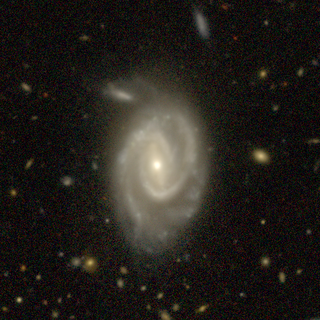
NGC 334 is a barred spiral galaxy in the constellation Sculptor. It was discovered on September 25, 1834 by John Herschel. It was described by Dreyer as "very faint, small, round, gradually a little brighter middle, 2 stars of 11th magnitude to south."
NGC 344 is a barred spiral galaxy in the constellation Cetus. It was discovered in 1886 by Frank Muller. It was described by John Louis Emil Dreyer as "extremely faint, very small, irregularly round, suddenly brighter middle and nucleus ."

NGC 359 is an elliptical galaxy located approximately 238 million light-years from the Solar System in the constellation Cetus. It was discovered on September 2, 1864, by Albert Marth. It was described by Dreyer as "extremely faint, very small."

NGC 361 is an open cluster in the Small Magellanic Cloud. It is located in the constellation Tucana. It was discovered on September 6, 1826, by James Dunlop. It was described by Dreyer as "very very faint, pretty large, very little extended, very gradually brighter middle." At an aperture of 31.0 arcseconds, its apparent V-band magnitude is 12.24, but at this wavelength, it has 0.40 magnitudes of interstellar extinction.

NGC 373 is an elliptical galaxy located in the constellation Pisces. It was discovered on December 12, 1876 by John Louis Emil Dreyer. It was described by Dreyer as "very faint, very small."
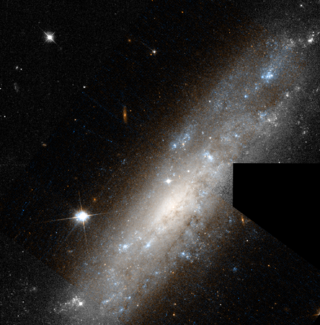
NGC 1003 is a spiral galaxy at the western edge of the Perseus constellation. It is located at a distance of about 36 million light years from the Milky Way and is receding with a heliocentric radial velocity of 624 km/s. This galaxy was discovered by the Anglo-German astronomer William Herschel on October 6, 1784, who described it as "pretty faint, large, extended 90°±, much brighter middle, mottled but not resolved". It is a member of the NGC 1023 group of galaxies.
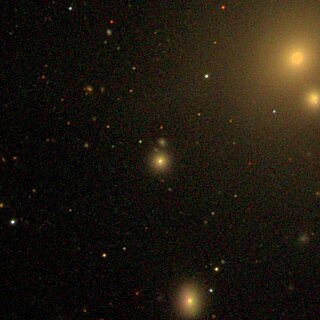
NGC 387 is an elliptical galaxy located in the constellation Pisces. It was discovered on December 10, 1873 by Lawrence Parsons. It was described by Dreyer as "very faint, small, round." Along with galaxies NGC 375, NGC 379, NGC 382, NGC 383, NGC 384, NGC 385, NGC 386 and NGC 388, NGC 387 forms a galaxy cluster called Arp 331.

NGC 397 is a lenticular galaxy located in the constellation Pisces. It was discovered on December 6, 1866 by Robert Ball. It was described by Dreyer as "extremely faint, small, round, very faint star to west."
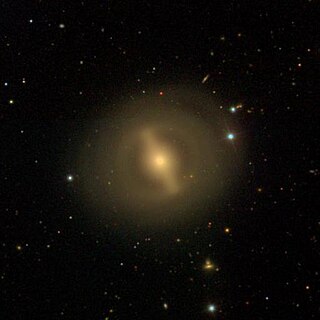
NGC 4608 is a barred lenticular galaxy located in the constellation of Virgo. The galaxy was discovered by astronomer William Herschel on March 15, 1784. At about 56 million light-years away, it is a member of the Virgo Cluster.

NGC 519, also occasionally referred to as PGC 5182, is an elliptical galaxy located approximately 242 million light-years from the Solar System in the constellation Cetus. It was discovered on 20 November 1886 by astronomer Lewis Swift.
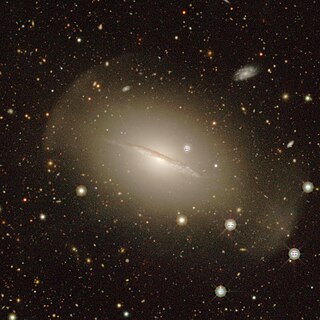
NGC 681 is an intermediate spiral galaxy in the constellation of Cetus, located approximately 66.5 million light-years from Earth. The name Little Sombrero Galaxy is a reference to a much larger and earlier observed sombrero-like galaxy designated M104, or the Sombrero Galaxy.

NGC 959 is a spiral galaxy in the northern constellation of Triangulum. It was discovered on November 9, 1876, by French astronomer Édouard Stephan. This galaxy is located at a distance of 36 million light years and is receding with a heliocentric radial velocity of 596 km/s. It is a member of the NGC 1023 Group of galaxies.




















